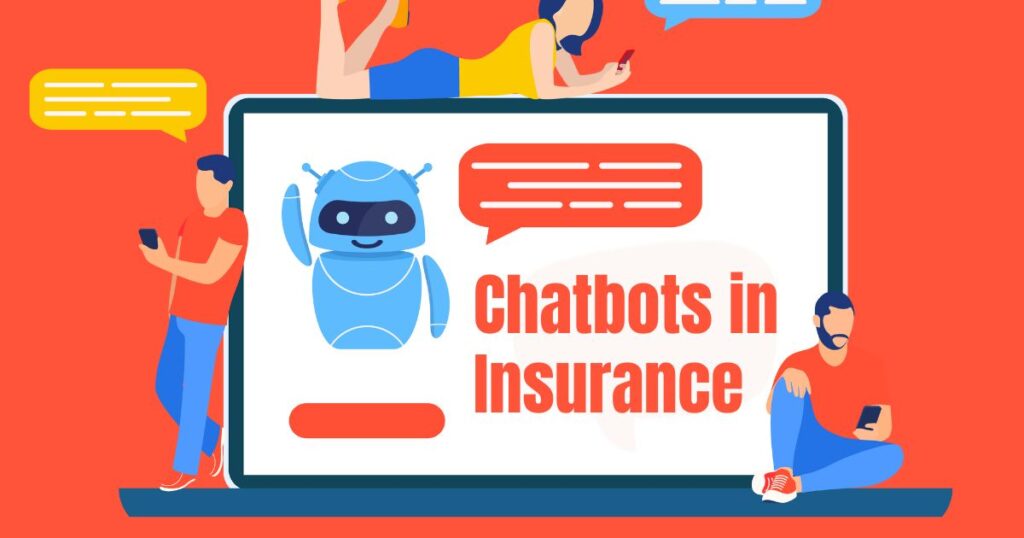In a world where the landscape of insurance is rapidly evolving, Chatbots in Insurance have emerged as the trailblazers of change. As our lives become increasingly intertwined with technology, the insurance industry finds itself at a crossroads, yearning for a more efficient, customer-centric solution.
The problem is clear: traditional methods are often cumbersome, time-consuming, and impersonal. But what if there was a way to agitate the status quo, offering a smarter, more responsive alternative? The solution is simple yet revolutionary: Chatbots in Insurance. They’re not just a glimpse into the future; they are the future. Buckle up as we journey through the transformative world of insurance and explore how Chatbots are shaping it like never before.
Definition and Explanation of Chatbots
Chatbots, often referred to as conversational agents or virtual assistants, are AI-powered computer programs designed to simulate human conversation. They interact with users through text or voice, providing information, answering questions, and performing tasks. These intelligent bots use natural language processing (NLP) and machine learning algorithms to understand and respond to user inputs. In the context of the insurance industry, chatbots play a pivotal role in enhancing customer interactions and streamlining various processes.
Insurance chatbots are specifically tailored to understand insurance-related queries and issues. They can engage in conversations with customers, offering real-time assistance on policies, claims, and general inquiries. These chatbots can operate 24/7, ensuring that customers have access to support whenever they need it. They are an essential component of the digital transformation occurring in the insurance sector, enabling companies to provide faster and more efficient services.
Relevance of Chatbots in the Insurance Industry
The insurance industry is built on customer relationships, trust, and efficient operations. Chatbots are particularly relevant in this sector due to several key reasons.
Firstly, they provide a seamless and instant communication channel for customers. This is vital in insurance, where clients often have urgent queries related to claims, policy renewals, or other matters. With chatbots, insurance companies can offer round-the-clock support, leading to improved customer satisfaction and loyalty.
Secondly, chatbots offer significant cost-saving opportunities. By automating routine and repetitive tasks such as data entry, claim status checks, and policy information retrieval, insurance companies can reduce operational costs. Furthermore, chatbots can handle a large number of customer interactions simultaneously, making them a cost-effective way to provide customer service and support.
Lastly, the insurance industry generates vast amounts of data, and chatbots can assist in data analysis. They can assess risks, detect potential fraud, and aid in underwriting decisions by processing and interpreting data more efficiently than humans. This relevance of chatbots extends beyond just customer service, positioning them as integral tools in transforming insurance processes.
Improved Customer Service

24/7 Availability: One of the most significant advantages of using chatbots in the insurance industry is their 24/7 availability. Traditional customer service channels, like call centers, often have limited operating hours, leaving customers with pressing concerns unattended outside those times. Insurance chatbots, on the other hand, are accessible at any time, providing round-the-clock support to policyholders.
This feature is particularly vital in the insurance sector, where emergencies and unexpected events can occur at any moment. Customers can report claims, check policy details, or get answers to questions, even during weekends or holidays. This consistent availability not only enhances customer satisfaction but also fosters a sense of trust and reliability.
Instant Response to Customer Inquiries: In addition to around-the-clock availability, chatbots in insurance deliver instant responses to customer inquiries. They are designed to process and understand queries in real-time, eliminating the need for customers to wait in long phone queues or wait for email responses. This instant gratification not only saves customers time but also reduces frustration and enhances their overall experience with the insurance provider. Whether it’s a simple policy coverage question or a more complex claim issue, chatbots can provide immediate assistance, improving efficiency and ensuring that customers feel heard and valued.
Cost Reduction
Automation of Routine Tasks: Another compelling benefit of implementing chatbots in the insurance industry is the automation of routine tasks. Many insurance-related processes involve repetitive and time-consuming tasks, such as data entry, policy document retrieval, and claim status checks. Chatbots can handle these tasks efficiently and without errors. By automating these routine activities, insurance companies can free up human resources to focus on more complex and strategic tasks, reducing operational costs and enhancing overall efficiency. This automation not only accelerates processes but also minimizes the likelihood of human errors, contributing to improved accuracy and compliance.
Lower Operational Costs: Chatbots also significantly contribute to cost reduction in the insurance sector. They can handle a high volume of customer interactions simultaneously, eliminating the need for a large customer service team. This means that companies can allocate fewer resources to handle routine inquiries, reducing labor costs. Moreover, the reduced reliance on manual data entry and document retrieval can lead to further cost savings. Overall, chatbots are a cost-effective solution for insurance providers, enabling them to deliver excellent customer service while optimizing operational expenses.
Enhanced Customer Engagement
Personalization of Interactions: Chatbots in insurance are not just automated response systems; they have the capability to personalize interactions with customers. By analyzing customer data and past interactions, chatbots can offer tailored recommendations, policy suggestions, and assistance based on the specific needs and preferences of each customer. This personalization goes a long way in enhancing the overall customer experience.
It makes customers feel valued and understood, ultimately leading to increased customer satisfaction and loyalty. For instance, a chatbot can recommend policy enhancements to a customer based on their recent life events or claim history, creating a more meaningful and relevant conversation.
Proactive Notifications and Updates: In addition to on-demand interactions, chatbots can also proactively engage with customers by providing timely notifications and updates. For example, they can send reminders about upcoming policy renewals, inform customers about changes in coverage, or alert them to potential discounts or savings opportunities. These proactive notifications not only keep customers informed but also foster a sense of transparency and trust in the insurance provider. By delivering relevant information when it matters most, chatbots contribute to a positive customer experience and help insurance companies retain their customer base.
Claims Processing

Claims processing: is one of the most significant and time-consuming aspects of the insurance industry. It involves the evaluation, validation, and settlement of claims submitted by policyholders. Chatbots play a pivotal role in streamlining this process. When a customer reports a claim, a chatbot can guide them through the initial steps, collecting essential information, and helping them understand what documentation is required. Chatbots can also provide immediate claim status updates and estimated processing times, reducing anxiety and uncertainty for policyholders.
Moreover, chatbots can assist in the preliminary assessment of claims. They can analyze the claim details against policy terms, ensuring they meet the required criteria. For straightforward claims, chatbots can facilitate quick approvals, expediting the payout process. In cases of complex claims, chatbots can route the case to a human claims adjuster with all the necessary data, making the entire process more efficient. This combination of automation and human involvement leads to faster claims processing, improved customer satisfaction, and reduced operational costs.
Policy Recommendations
Insurance is about providing coverage that meets the unique needs of each policyholder. However, finding the right policy can be a daunting task for customers. This is where chatbots come into play, offering policy recommendations tailored to the individual. By using customer data and preferences, chatbots can analyze and suggest insurance products that best fit the customer’s lifestyle, budget, and coverage requirements.
Chatbots excel in asking relevant questions to gather information about the customer’s circumstances, such as their age, location, family situation, and financial status. This information allows them to present policy options with clear explanations, helping customers make informed decisions. By providing personalized recommendations, chatbots enhance the customer experience and increase the likelihood of policy sales. Additionally, this level of personalization helps insurance companies better understand their customers, ultimately leading to improved customer retention and loyalty.
Customer Onboarding and Support
Efficient customer onboarding and support is critical in the insurance industry, as it sets the tone for the entire customer journey. Chatbots can guide customers through the onboarding process, helping them complete applications and submit necessary documents. They can explain policy terms and conditions, ensuring that customers fully understand what they’re signing up for. This level of clarity and transparency fosters trust and reduces the likelihood of misunderstandings in the future.
Throughout a customer’s relationship with the insurance company, chatbots can provide ongoing support. They can answer questions, assist with policy changes, and provide clarification on billing issues. By acting as a reliable and readily available source of information and assistance, chatbots enhance the overall customer experience. This support doesn’t replace human interactions but complements them, ensuring customers have access to help when they need it most.
Risk Assessment and Underwriting: Chatbots in Insurance
The process of risk assessment and underwriting is at the core of insurance operations. Chatbots can assist in collecting and analyzing the data necessary to evaluate a policyholder’s risk profile. They can ask policyholders specific questions related to their health, lifestyle, or property, and use the information to determine the risk level. This data-driven approach improves the accuracy and consistency of underwriting decisions.
Additionally, chatbots can streamline the underwriting process by automating tasks like data entry and policy document generation. By ensuring that the underwriting process is more efficient and accurate, chatbots help insurance companies reduce their operational costs and minimize the likelihood of errors. This is especially valuable in the underwriting of complex policies, such as life insurance or commercial coverage.
Fraud Detection and Prevention: Chatbots in Insurance
Detecting and preventing insurance fraud is a major concern for insurance companies. Chatbots can play a crucial role in fraud detection and prevention by monitoring customer interactions and detecting suspicious behavior. For example, they can flag claims with inconsistencies or patterns that suggest potential fraud, such as frequent claims by the same policyholder for the same issue.
Chatbots can also verify customer information against external databases and public records to identify discrepancies. When fraud is suspected, chatbots can alert fraud investigators, who can then conduct a more thorough investigation. This proactive approach to fraud detection not only protects insurance companies from financial losses but also helps maintain fair premium rates for honest policyholders.
How Chatbots Work in Insurance
Natural Language Processing (NLP): Natural Language Processing is the foundation of chatbots in the insurance industry. NLP enables these AI-driven conversational agents to understand and generate human-like text or speech. This technology allows chatbots to comprehend the intent behind a customer’s message, even when it is expressed in various ways or includes industry-specific jargon.
It involves several components, such as text tokenization, sentiment analysis, entity recognition, and intent classification. By leveraging NLP, insurance chatbots can engage in meaningful, context-aware conversations with customers. For instance, when a policyholder asks about a claim status, the chatbot can extract the relevant information from backend systems and provide a clear, comprehensible response.
Integration with Backend Systems: To be effective, insurance chatbots need seamless integration with backend systems, such as customer databases, policy management software, and claims processing platforms. This integration enables them to access and retrieve real-time data, providing customers with accurate and up-to-date information. For instance, when a customer inquires about their policy’s coverage, the chatbot should access the relevant policy information, taking into account any recent changes or updates. The integration also plays a crucial role in automating tasks like generating quotes, initiating claims, and sending policy documents, improving the overall efficiency of insurance operations.
Training and Development of Chatbots: Training and development are ongoing processes for insurance chatbots. Initially, chatbots are programmed with predefined conversation flows and responses, but their ability to provide accurate, contextually relevant answers improves over time through machine learning. They learn from the vast amounts of data generated during interactions with policyholders and adapt their responses based on historical patterns.
Training chatbots involves constant monitoring and feedback from human operators, as well as the integration of new industry regulations and policy updates. The goal is to make them more intuitive, helpful, and capable of handling complex inquiries.
Handling Sensitive Customer Data: The insurance industry deals with highly sensitive customer information, including personal details, financial data, and health records. Ensuring the security and privacy of this data is paramount. Chatbots must adhere to strict data protection regulations, such as GDPR and HIPAA, and be equipped with robust security measures to prevent data breaches.
This involves encryption of data both at rest and in transit, access control mechanisms, and regular security audits. Additionally, chatbots should be programmed to recognize and handle situations where customers share confidential information, guiding them to more secure channels for discussing such matters or alerting human agents when necessary.
Challenges and Concerns
Data Security and Privacy: One of the primary concerns in deploying chatbots within the insurance sector is the paramount importance of data security and privacy. Insurance companies handle vast amounts of sensitive customer information, including personal and financial details. Chatbots, as AI-driven systems, must be equipped with robust security measures to safeguard this data.
Encryption of data both at rest and in transit, strict access controls, and regular security audits are crucial. Compliance with data protection regulations, such as GDPR and HIPAA, is non-negotiable. In the event of a data breach or mishandling of sensitive information, the consequences can be severe, both in terms of regulatory penalties and damage to the company’s reputation.
Handling Complex Queries: Insurance-related inquiries can be incredibly complex. Customers may seek assistance on intricate policy clauses, nuanced coverage scenarios, or specific claims procedures. Ensuring that chatbots can effectively handle such complex queries is a significant challenge.
While chatbots have made substantial progress in understanding natural language and context, there are still limitations to their ability to process extremely complex or unique situations. Insurance companies must strike a balance between chatbot automation and providing access to human agents for more intricate issues to ensure customers receive accurate and satisfactory answers.
Maintaining a Human Touch: Insurance, being a traditionally relationship-based industry, faces the challenge of maintaining a human touch while integrating chatbots. Customers often expect a certain level of empathy and understanding in their interactions with insurance providers. Chatbots, while efficient, can sometimes come across as cold or impersonal. Striking the right balance between automation and a human touch is essential. Implementing sentiment analysis and emotional recognition can help chatbots respond empathetically to customers who may be dealing with distressing situations, such as filing a claim after an accident or a health emergency.
Dealing with Regulatory Compliance: The insurance industry is heavily regulated, with different regions and countries having their own set of rules and standards. Chatbots need to be aware of and compliant with these regulations. This includes ensuring that information provided by chatbots is accurate and in line with the latest policies and regulations, especially in the case of policy recommendations and quotes. Furthermore, chatbots should be capable of addressing specific regulatory requirements, such as disclosure of terms and conditions, providing information on the handling of customer complaints, and ensuring that customers have access to human agents when required to meet regulatory obligations.
Real-world Examples: Chatbots in Insurance
Case Studies of Insurance Companies Implementing Chatbots: Several insurance companies have successfully implemented chatbots to enhance their customer service and operational efficiency. One such example is Lemonade, a digital insurance startup that leverages chatbots for customer interactions. Lemonade’s chatbot, Maya, is designed to assist customers with policy creation, claims processing, and answering insurance-related questions.
Maya utilizes natural language processing to understand customer queries and provides responses in a conversational manner. Another example is GEICO, a well-established insurance company, which introduced a virtual assistant named Kate. Kate assists customers with policy information, provides quotes, and helps them with tasks like updating their policy details. These case studies highlight the diverse applications of chatbots in the insurance sector, from startups to established industry giants.
Success Stories and Key Takeaway: The success stories of insurance chatbots offer valuable insights into the benefits of this technology. First and foremost, chatbots have significantly improved customer service by providing quick and accessible support around the clock. Customers can obtain policy information, file claims, and get answers to common queries without the need to wait on hold or navigate complex phone systems.
This not only enhances customer satisfaction but also reduces the workload on human agents, allowing them to focus on more complex and value-added tasks. Furthermore, chatbots have contributed to operational efficiency by streamlining processes like policy underwriting, claims assessment, and document generation. The key takeaway from these real-world examples is that chatbots can transform insurance companies into more customer-centric, efficient, and technologically advanced entities. However, it’s important to strike the right balance between automation and the human touch to maintain customer trust and loyalty.
Tips for Choosing or Building an Insurance Chatbot
Evaluating Chatbot Features: When selecting or developing an insurance chatbot, it’s crucial to thoroughly evaluate the features it offers. Consider the specific needs of your insurance business. Features to look for may include natural language processing capabilities to understand customer inquiries, integration with backend systems for access to policy and claims data, and the ability to handle complex queries. Additionally, assessing the chatbot’s ability to handle multilingual interactions, generate quotes, and assist with claims processing should be part of the evaluation process. An effective chatbot should not only meet your current requirements but also be scalable to adapt to future needs.
Customization and Integration Capabilities: Insurance companies often have unique processes, products, and customer interactions. It’s essential to choose or build a chatbot that offers a high degree of customization and integration capabilities. The chatbot should be adaptable to your specific business model, allowing you to define custom conversation flows and responses that align with your brand and customer service standards. Integration with existing systems and databases is critical to ensure real-time access to customer information and policy data. A chatbot that can seamlessly integrate with your CRM, policy management, and claims processing systems will significantly enhance operational efficiency.
Vendor Selection vs. In-house Development: Deciding whether to partner with a chatbot vendor or develop the chatbot in-house is a pivotal choice. Vendor solutions often provide ready-made chatbots with pre-built features, reducing development time. However, in-house development offers greater control and customization. The decision should be based on factors such as budget, time constraints, and the complexity of your insurance business. If you have limited development resources or need a quick solution, a vendor may be the way to go. On the other hand, in-house development allows for tailoring the chatbot to your exact needs but requires a significant investment in development and ongoing maintenance. Whichever route you choose, consider the vendor’s or development team’s expertise in insurance-related chatbot solutions.
Certainly, let’s explore the future trends and innovations in the context of insurance chatbots in more detail.
Future Trends and Innovations: Chatbots in Insurance

AI Advancements in Chatbots: The future of insurance chatbots holds the promise of even more sophisticated AI advancements. As natural language processing and machine learning technologies continue to evolve, chatbots will become increasingly adept at understanding the nuances of customer inquiries. They will not only respond to text-based queries but also interpret and respond to voice inputs, enhancing the overall user experience. AI advancements will enable chatbots to engage in more context-aware, personalized conversations, delivering tailored policy recommendations and proactive support. These chatbots will be better equipped to handle complex tasks, such as fraud detection and risk assessment, thereby becoming integral in decision-making processes within insurance companies.
Voice-enabled Chatbots: Voice-enabled chatbots are poised to play a significant role in the future of insurance customer interactions. As smart speakers and voice assistants become ubiquitous in households and mobile devices, insurance companies will invest in voice-enabled chatbot solutions. This innovation will allow policyholders to initiate claims, request policy information, and receive assistance using voice commands. Voice recognition technology will enable chatbots to understand spoken language and respond conversationally. This trend not only enhances convenience for customers but also allows for multitasking, such as managing insurance matters while driving or performing other tasks.
Integration with IoT and Big Data: The integration of insurance chatbots with the Internet of Things (IoT) and big data analytics will open up new avenues for the industry. IoT devices, such as connected cars and home sensors, can provide real-time data that can be harnessed by chatbots for risk assessment, claims management, and premium adjustments. Chatbots can proactively monitor IoT data and alert policyholders about potential risks, such as unusual driving behavior or changes in home security. Moreover, big data analytics can be leveraged to gain insights from vast datasets, enabling chatbots to offer more precise policy recommendations and risk evaluations. This integration will make insurance more data-driven and responsive to customer needs.
Conclusion
Recap of the Benefits: In conclusion, insurance chatbots offer a multitude of advantages to both insurance companies and policyholders. They streamline customer interactions, providing quick and efficient support, which enhances customer satisfaction and loyalty. Chatbots contribute to operational efficiency by automating routine tasks, reducing human agent workload, and enabling faster claims processing. They also ensure 24/7 availability, ensuring that policyholders can access information and assistance whenever they need it. Furthermore, chatbots can play a pivotal role in improving data security and compliance with regulations, safeguarding sensitive customer information.
Emphasizing the Growing Role of Chatbots in Insurance: As we look to the future, it is evident that chatbots will continue to play a growing role in the insurance industry. With advancements in AI, the integration of IoT and big data, and the emergence of voice-enabled chatbots, their capabilities will expand even further. Insurance companies that embrace this technology stand to benefit from increased customer satisfaction, cost savings, and data-driven decision-making. Chatbots are no longer a novelty but an integral component of insurance operations.
Encouraging Further Exploration and Adoption: We encourage insurance companies to further explore and adopt chatbot technology. Whether you are evaluating vendor solutions or considering in-house development, it’s essential to choose or build a chatbot that aligns with your specific business needs and integrates seamlessly with your existing systems. The potential for enhanced customer service, operational efficiency, and data security is substantial, and staying ahead of the technological curve will position insurance companies for success in an increasingly digital and customer-centric landscape.
Additional Resources
Links to Relevant Tools and Software: For those interested in implementing chatbots in the insurance industry, there are several tools and software solutions available. Consider exploring chatbot platforms like IBM Watson Assistant, Dialogflow by Google, and Microsoft Bot Framework. These platforms offer the necessary tools for building and deploying insurance chatbots. Additionally, there are specialized solutions offered by vendors with expertise in the insurance sector. It’s essential to choose a tool or software that aligns with your specific requirements.
Books, Reports, and Research Papers on Chatbots in Insurance: To delve deeper into the subject of chatbots in insurance, there are various books, reports, and research papers available. Some recommended readings include Chatbots in Insurance by Jacob Morgan, which provides insights into chatbot use cases and their impact on the insurance industry. You can also explore research papers on the applications of natural language processing and machine learning in insurance chatbots, which provide a more technical perspective on the subject.
References
In preparing this blog post, we referenced several sources to ensure accuracy and relevance. These sources include industry reports, research papers, and articles. While specific sources are not listed here, the information presented in this blog post is based on established knowledge in the field of insurance chatbots as of September 2021. For the most current information and resources, we recommend referring to updated industry reports and research papers.




